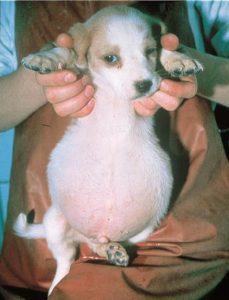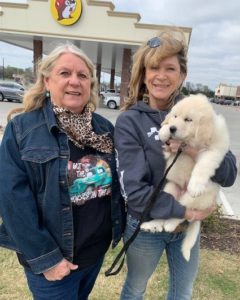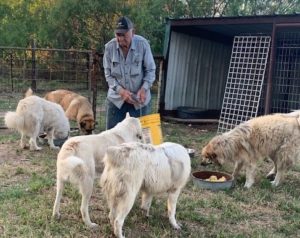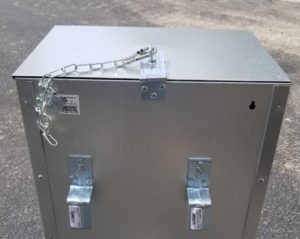This is a new section to The Guardian Way in which I will give you a brief update on things happening for me at home and work. In May, my twin boys graduated from high school in Grape Creek. Although it was not your traditional ceremony, which I’m sure most were not this year, the boys were excited and happy to finally put that chapter of their lives behind them. It was sad for me, being a former teacher who saw so many traditional graduations of my past students, to miss out on that tradition with my own sons. Grape Creek High School did a great job with the video they presented. It was also a nice touch for them to send home a flash drive with professional pictures of the student’s individual ceremonies and parent and graduate pictures.
We are supposed to all be back to work at the center by August 1 baring anything else halting working from the office from the Covid-19 pandemic. Hopefully our travel ban will be lifted too, and I will be able to start visiting producers again. I learn something each time I have a producer visit. I also completed the process of developing my first LGD factsheet, How to Select an LGD Puppy. The factsheet can be found on our website at https://sanangelo.tamu.edu/research/lgd/.
Internal Parasites – Gastrointestinal

This is the first part of a multi-part series on canine gastrointestinal parasites. The most common type of internal parasites that an owner of LGDs will encounter are worms. There are five main types of worms that your dog may encounter: roundworms, hookworms, whipworms, tapeworms and flukes.
The large roundworms known as ascarids are common in dogs, especially in puppies. The most important species is Toxocara canis because infections are common. Fatal infections may occasionally be seen in young pups. Toxascaris leonina is typically much less common and is generally seen in older dogs.
Adult dogs often have some resistance to infection. However, during whelping of a litter, the immunity of the female dog to infection is partially suppressed. Often the inactive larvae become active, crossing the placenta to the pups and sequestering in the mammary tissue. When the puppies nurse they are transmitted in the colostrum and milk. Due to immune system suppression at the time of whelping, active infections may occur in the pregnant dog, with large numbers of eggs passed in the feces.
In puppies, round worm infection usually occurs by transfer into the developing fetus through the placenta. The worms can be found in the intestines of the puppies as early as 1 week after birth. Pups may also be infected while nursing. If pups less than 3 months old eat the eggs that have been in the environment for at least 4 weeks, the eggs will hatch, releasing larvae that penetrate the intestinal wall. The larvae migrate through the liver, reach the lungs via the bloodstream, are coughed up, swallowed, and mature to egg-producing adults in the small intestine. Many larvae will be carried by the bloodstream to other parts of the dog’s body and remain in the tissues of the dog for years in an inactive form.
Puppies often show no signs of infection. The first indication of infection in young animals is lack of growth and loss of condition. Infected

dogs may have a dull coat and often appear “potbellied.” Worms may be vomited out and are often passed in the feces. In the early stages, migrating larvae may cause pneumonia, which can be associated with coughing. Diarrhea with mucus may also be evident. Infection in dogs is diagnosed by detection of the roundworm eggs in feces using a microscope.
There are several compounds available for treating roundworm infections in dogs. Transmission of infection from mother to newborn can be greatly reduced by a program of antiparasitic drugs given during pregnancy and after the birth of a litter. Pups should be treated as early as possible. Ideally, treatment should be given 2 weeks after birth and repeated at 2- to 3‑week intervals to 2 months of age, then monthly to 6 months of age. We use a liquid wormer that is given orally for the pups at the AgriLife Center. Nursing dogs should be treated on the same schedule as their pups.
LGD Puppy Bonding Project

Waylon has finally rejoined the other two pups and is healing up well from his injuries in early May. He required several stitches and three vet visits before we were able to get his infection under control from one of the wounds. For more information on this incident you can check out the video at this link https://www.youtube.com/watch?v=-QB2nRHALLE
All three of the Legends of Country Music are doing well in the bonding project and are staying close to their Dorper ewes. We recently introduced some rams in with the ewes and are observing how the pups are interacting with the breeding process. We will be keeping this set of pups for protecting some of our own livestock at our research ranch in Menard. They will stay at the Center until 8 months of age before being released with a couple of older dogs to guard our Dorper sheep in Menard.
The Superhero’s and Stooges are all still doing well. We will continue to track the six pups with GPS trackers until they are 18 months old and take note if they are staying together or wandering to other locations. We will be bonding our next set of six pups in September.
Maggie and Marley, the Kangal pups that were donated to the program back in the late winter, have started wandering for some reason.

After several attempts to contain them at the Sonora Station, we decided to bring them back to San Angelo for monitoring and retraining. They have been placed in our bonding pens with electric fence to prevent climbing and digging out. We will keep you posted on how the girls are progressing. We are not sure what made them start wandering other than adolescence. They have been great dogs up to early June when they started to dig and/or climb out of their pasture and leave their goats unguarded. They had been raised with sheep and goats by the breeder and we bonded them to our goats before releasing them. Hopefully we will be able to retrain them and place them back to work in Sonora or one of our other ranches soon.
LGD Breed Spotlight –

Although uncommon in the United States, the Estrela Mountain Dog is popular in other countries. The dog got its named for the Estrela Mountains in Portugal and is believed to be the oldest breed in the region. The breed has several distinctive characteristics including rose ears that are folded backwards against the head, a black mask and a hook on the end of its tail. They are a faithful flock guardian, protecting against predators and thieves. They are distrustful of strangers but typically docile towards their masters.
The earliest of the Estrela ancestors were herd-guarding dogs in the Serra da Estrela, in what is now Portugal, and are one of the oldest breeds in that region.
Shepherds have chosen to breed the dogs that had the characteristics necessary to survive in their mountain environment. They want dogs fit to do their job: large-sized, strong, having endurance, agile, deep-chested, able to tolerate a marginal diet, a proper set of legs, a powerful mouth, a tuft of hair around its neck, an easy, jog-like gait and a warm coat. The Estrela’s have a watchful, mistrustful, yet loyal temperament. The dogs are expected to move from their spot of guarding to bring the stragglers back, and then assume a leadership position at the head of the flock. They are accomplished climbers and jumpers, so good fences are a must with this breed.
The dogs come with long or short haircoats. During the 1950s, the long-haired variety was popular at shows, but show dogs represented only a small portion of the Estrela population in Portugal, and still do. Many of the working dogs are short-haired. The hair coat ranges in colors from light fawn to dark mahogany to wolf gray with or without brindle markings. Fawn colored dogs are most popular in the longer haired variety while brindle is common in the shorthaired dogs. Short haired dogs are rarely seen outside of Portugal. The dog’s range in weight from 80-115 pounds and range in height from 23-30 inches. They have a broad skull, long head and tight lips with oval eyes that are dark amber.
Sources: https://www.estrelamountaindogassociation.com/the-breed-standard, Dohner, Janet Vorwald. Farm Dogs: A Comprehensive Breed Guide to 93 Guardians, Herders, Terriers, and Other Canine Working Partners. Storey Publishing, 2016.
Breeder Profile

This month’s LGD breeder and rancher that is effectively using LGDs in their operation is Connie Wilson of WW Livestock Guard Dogs.
Q: Describe your operation/ranch.
- How many LGDs do you currently use?
- Explain your LGD program.
A: I live on a small 23-acre place with my best friend Jimmie Willenberg on a major road between San Marcos and Luling. I raise sheep, goats, and Livestock Guard Dogs. I started raising Livestock Guard Dogs to protect my animals. I currently have around 50 dogs –from puppies, to breeding males and females, to dogs that are ready to work.
Jimmie Willenberg and I got together around 2002. He has around 400 acres near Red Rock, Texas. He first tried wool sheep on his place. We raised pups out of Bobby Joe and Pearl and put them on his place to protect the sheep. They were successful in controlling the coyote problem. But after the first couple of years of trying to the pay shearers and sell wool, he decided to stock his place with goats.

We had too many goats for my small place, so we started buying goats to stock his place. Our Livestock Guard Dogs started multiplying and we had enough to put on his place and sell a couple. After a few years, the goats just got too much to handle. Jimmie had previously had a cattle pre-conditioning operation on his place. The fences were not meant to hold goats. So, Jimmie decided to try Dorper Sheep. This was truly an answer to prayers. He has about 1,350 head and eight or nine dogs on his place.
I start feeding the puppies a few days after their eyes are open. I feed them powdered goats’ milk and Purina One for large dog puppy feed. I will feed them twice a day until they are about ten weeks old, if they are still here. We deworm at four weeks or sooner if they look like they need it. Puppies and dogs’ gums will turn a grey or ash color if they need deworming. If you notice it, do it very carefully over a few days because they are already weakened condition.
We give them their first puppy shots at six weeks. Then again, every six weeks for a year if they are still here. We have had trouble with Parvovirus in the past. We do all we can to keep our pups and lactating females, vaccinated and in a clean dry area. We don’t sell pups until they are at least eight weeks old. They run with the sheep and goats with their mothers and the other dogs. We still catch the pups and feed them separately twice a day.
We raise these pups for our use and sell extra pups. All these pups and dogs have a job. We pen males up when we have enough puppies. If we don’t sell puppies, we will keep them and use them on our own places.
Q: What got you started in breeding LGDs?
A: It all started with two terribly flea-bitten puppies, a male and female we purchased from some folks that had Pyrenees dogs years ago. I wasn’t even sure they would make it. They were wild puppies and had never been handled. But after several baths, lots of time, and lots of love, they grew to be a beautiful pair of dogs. They were called Pearl and Bobby Joe. We named them after dear friends, that were pillars in our rodeo community.
Q: How long have you bred LGDs?
A: Since about 2002.
Q: What breed of LGDs do you raise?
A: My place, where we raise the pups, is small. I have it broke up in several different pastures. We have sheep and goats, so these dogs are exposed to both. We raise some Pyrenees, Anatolian/Pyrenees cross, and Armenian Gampr dogs. We started crossing Anatolian/Pyrenees dogs to try to get a shorter haired dog because of the heat here in Texas. The Armenian Gampr dog is a livestock dog that originated in Armenia. They are a little more aggressive than the Pyrenees, but they have a loving protective attitude toward their family and their stock. We have a registered pair and have some pups.
These dogs all work. This is through nothing I do other than give them the opportunity to do what the good Lord created them to do, protect His sheep.
Q: Do you have an LGD mentor?
A: Yes, we had known about Great Pyrenees dogs because Bob Buchholz and his brother, Dave. They had been putting Great Pyrenees with goats on their property and leased places since the seventies, maybe longer. They had grown up in goat production and I had known them since I was in 4H or longer.
I truly think my Daddy loved these two boys more than my two sisters and I. Daddy, R. B. Wilson, built a home, barn, and arena on his place near Driftwood, Texas around 1985. My sisters and I had all married and moved away from home. Bob and Dave would go to Daddy’s and practice team roping. Daddy treasured the time he spent with the “Buchholz Boys” at his roping arena. He would tell stories and just laugh! They were both great young men that enjoyed their horses and roping. They were also hard workers that always had goats and dogs for their protection.
It was only natural, when I got Bobby Joe and Pearl, the first person I would call for advice was Bob Buchholz. As you well know, if you live anywhere in the goat or dog community, he is your go-to person! He and his brother Dave’s experience spans from their teens to now. They don’t just know it, they live it! Big difference!
Q: What’s the one thing you wish you knew before starting to breed LGDs?
A: It is important they are exposed to all elements: heat, cold, rain, dry, goats, sheep, lambs, kids, horses, trucks, trailers and people. Our goal is to raise a dog that will be comfortable in any situation on anyone’s place. We have just started teaching them to tie. Mainly, from coaching from Bill Costanzo and John Walker from Texas A&M AgriLife. We don’t lead them, as most of the time they just follow us. However, these dogs do have to be able to be handled and given shots or taken to a vet when necessary.
Q: What is the number one thing you recommend to a new LGD user?
A: Puppies will play with lambs and kid goats. Every morning when I feed my sheep the ewes will pen and maybe a few of the babies will not. I have noticed if I try to run and the head the lambs, the puppies will chase them, too. If I calmly walk and push them toward the gate the pups just follow my lead. If a pup gets rough or chases a lamb, I am there to correct them immediately. I will tell them ‘no’ or tap them with a stick if necessary.
If you have a pup that gets rough with sheep, a lamb, or a kid goat just pen them up in the pen when you feed the sheep or goats. The ewes or nannies will teach a pup more than you can. If the sheep and goats are being too rough on the puppy, step in and save the day. Pick up the pup and love him. He will know you as a safe place and he has learned to keep an eye on those mean mamas.
Q: What is your favorite LGD or LGD story and why?
A: It is one that works. My experience is different people look for different things. Some want aggressive dogs; some want a dog their kid can play with. All want a dog that protects their animals.
The research and seminars provided by the AgriLife Livestock Guardian Dog Program have been extremely beneficial. It has given us a platform to discuss problems, meet and visit with other dog breeders and ranchers, and to improve our management programs. The tracking systems and studies done show that these dogs are where they need to be, when they need to be. We have received the same feedback from ranchers watching these dogs daily. Thank you to the AgriLife Livestock Guardian Dog Program for putting like-minded people together with good working dogs to maintain predator control.
LGD Timely Tips
Every Tuesday check out our Facebook page @TAMUlivestockguardog for Tuesday’s LGD Tip of the Week!
- Use dog-proof raccoon traps at your feeding stations to eliminate feed waste. Make sure to have one of the tools to make them easier to set!
- Use some sort of lock to keep raccoons from getting inside your dog feeder.
- Place your dog’s feeding station at a watering location for your stock so the dog doesn’t have to leave them to eat. If you have large pastures, you may want to place a dog feeder at every water location.
To provide feedback on this article or request topics for future articles, please contact me at bill.costanzo@ag.tamu.edu or 325-657-7311.
Bill Costanzo
Research Specialist II, Livestock Guardian Dogs
Follow us on Facebook: https://www.facebook.com/TAMUlivestockguarddog/
Follow us on YouTube: https://www.youtube.com/channel/UCF7YbP6bNDV7___6H8mifBA



